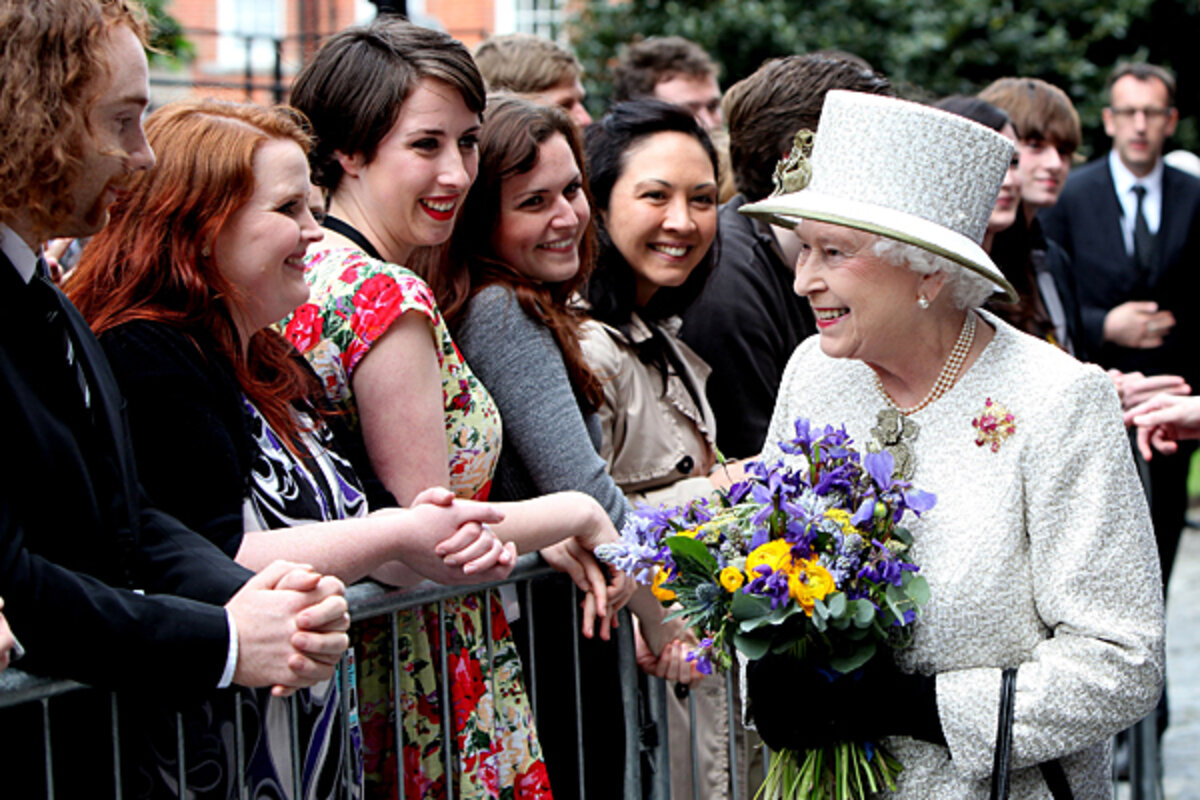Queen's visit to Ireland symbolizes more 'normal' relationship
Loading...
| Dublin, Ireland
Perhaps the most notable aspect of Queen Elizabeth II's trip to the Republic of Ireland is its normalcy.
To be sure, tight security surrounds the trip, which was marred by several bomb threats. And much has been made of its historic nature – the first visit by a reigning British monarch to the republic and the first royal trip to Dublin in 100 years since George V came to the city, which was then under British rule.
Irish Prime Minister Enda Kenny characterized the trip as a “symbolic conclusion to many years of difficulty” that span the division of Ireland in 1921 and the 30-year Northern Ireland conflict that drew to a close in 1998.
IN PICTURES: Queen Elizabeth visits Ireland
But Belfast-based author and commentator Malachi O’Doherty says the mythmaking that has accompanied the visit obscures the already normal relationship between the two countries and their populations.
“The danger in framing this visit as a completion of peacemaking and the 'bookending' of the Troubles [in Northern Ireland] is that, with protests and security, it will look like a failure. We are generating the myth that the British and Irish states have been perpetually hostile toward each other until now – this is nonsense."
Strong trading partners
Britain has long been Ireland's largest trading partner. In 2010, Ireland exported goods valuing a total of €13.8 billion (approx. $19.6 billion) to the United Kingdom, something that would not have occurred if the two states were at loggerheads. In addition, the British government estimates that around 3 million of its citizens visit Ireland as tourists annually.
Stepping off the plane at Casement military airbase in Baldonnel, County Dublin, the queen sported an emerald green dress coat that many took as a symbolic gesture. Her arrival came amid bomb threats from dissident Irish republicans opposed to the visit and to continuing British rule in Northern Ireland. Six incidents, including a pipe bomb discovered on a bus traveling to the capital from Maynooth in county Kildare, south-west of Dublin, have been recorded. A controlled explosion on the device was last night by the Irish Army. The other threats are thus far thought to have been hoaxes, called-in in the hope of disrupting the occasion.
Accompanied by her husband, Prince Philip, the queen was whisked off to Áras an Uachtaráin, the official residence of the Irish president, where they met and dined with Ireland’s outgoing president, Mary McAleese, and her husband, Martin. Formerly the residence of Britain’s governor general in Ireland, it is now occupied by Belfast, Northern Ireland-born President McAleese, whose second term as head of state ends this year.
McAleese was named as being among the 100 most powerful women in the world by Forbes in 2009, largely for her work toward cementing peace in Northern Ireland.
She first mooted the idea of an official state visit by the British monarch in 1998.
'Genuine friendship'
Both British and Irish politicians have stated that the royal visit indicates solid relations between the two countries. Britain’s prime minister, David Cameron, who arrives in Ireland tomorrow, said the visit showed “genuine friendship” between the two countries.
None of which is to say the visit is passing without complaint. Police and protesters engaged in minor scuffles early this afternoon near the Garden of Remembrance, an official memorial to Irish republicanism, where the Queen laid a wreath shortly after 3.30PM.
The royal entourage then moved on to visit Trinity College Dublin, founded in 1592 under the aegis of Queen Elizabeth I, to view the famous Book of Kells manuscript.
Irish police described the clashes as “minor public order events.”
Despite the clashes and two separate protests from socialist party É����í��í and Republican Sinn Féin (the party linked to the still armed dissident Continuity IRA, founded in a split from mainstream Sinn Féin in 1986), objections to the queen’s visit have, for the most part, taken on a para-political nature, often focusing on the cost of security (estimated at $42.5 million) or frustration at road closures.
One thing the queen will not see a lot of during her visit is the Irish public. Much of Dublin is sealed off and anyone attempting to enter the area of the visit is searched. Although some well-wishers have come out, the streets are deserted in comparison to a typical day in the city.
Dena Walker, an English citizen who lives in Dublin and works in advertising, says she has experienced some anti-English sentiment, albeit mild.
“Nobody is complaining about roads being closed for when Obama comes later this month,” she says.
“I hear a lot of ‘you’re English but you’re OK.’ I’m completely accepted here in Ireland, but there is an ingrained feeling [of grievance at Britain] and it’s nothing to do, to me, with the country [modern Britain] I know.”
Ralph Croly, who lives near Dublin’s Phoenix Park, the location of Áras an Uachtaráin, says he is mildly in favor of the visit but largely uninterested in it.
“I think it’s a good thing that’s she’s visiting, but I’m not bothered [either way],” he says. “Beating England in rugby was better.”
The four-day visit continues tomorrow with stops at the Guinness brewery, the Irish National War Memorial Garden and sports stadium Croke Park, itself a noted republican shrine. Thursday, the visit moves outside of Dublin to the National Horse Stud in county Kildare, concluding on Friday with a visits to county Tipperary and Cork city.
A reciprocal state visit to Britain by Ireland’s president is expected next year.




